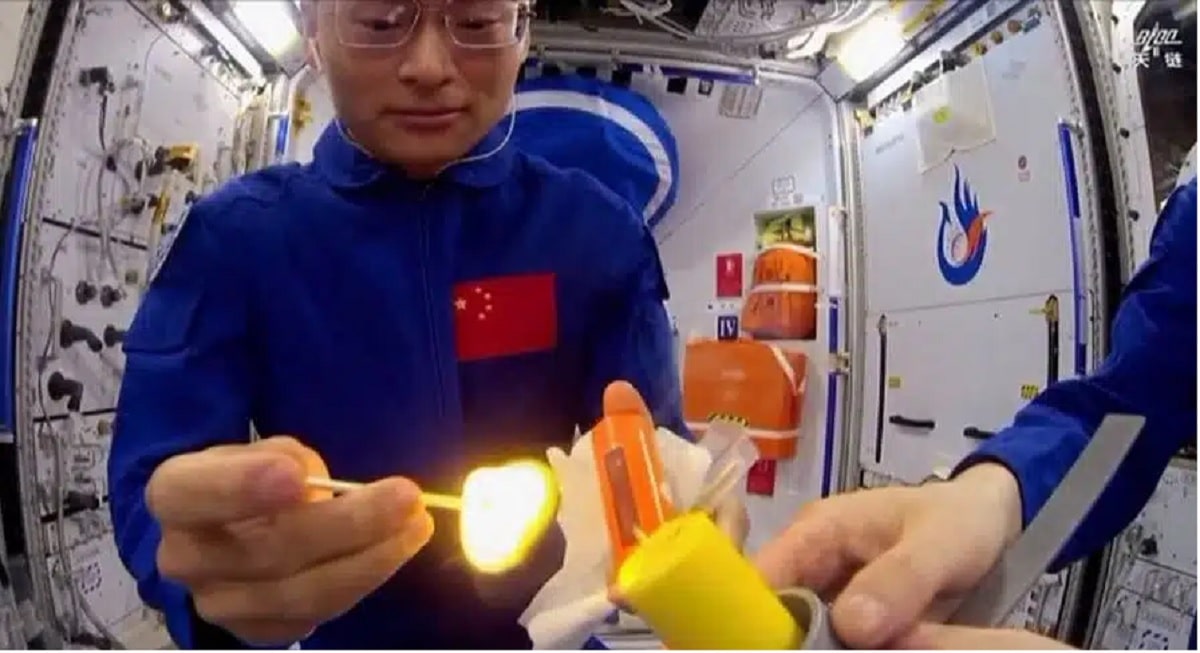Lighting a Flame in Orbit
On China’s Tiangong station, a simple match turned into a striking demonstration of physics. When astronauts Gui Haichao and Zhu Yangzhu ignited a candle during a live lesson, the flame behaved in an unexpectedly calm way. Instead of a dancing, teardrop shape, the fire formed a gentle, almost spherical glow. That quiet orb revealed how microgravity reshapes heat, air, and combustion at their most basic level.
During the broadcast to classrooms across China, the astronauts showed how a small flame changes when gravity no longer drives hot air upward. The result was mesmerizing: a slower, bluer burn, diffusing evenly through its immediate environment. A familiar household act became a window into unfamiliar physics.
Why Flames Look Different in Space
On Earth, a candle’s flame rises because hot air becomes buoyant and climbs, pulling cooler oxygen in from below. This convection produces the classic teardrop profile, with yellow outer glow and a hotter blue core. The flame flickers as turbulent eddies feed and starve it in rapid cycles.
In orbit, convection is drastically muted. Without buoyancy, gases don’t separate into neat layers or currents. The flame expands equally from its source, creating a round, slow, and surprisingly stable sphere. Oxygen arrives by diffusion, not draft, so burning is gentler and often cooler. The chemistry still works, but the choreography is entirely new.
This diffusion-led burning makes flames look smaller and softer, yet they can persist longer near a fuel source. That behavior challenges our Earth-trained instincts about heat, smoke, and safety. The spectacle is subtle, but the underlying implications are profound.
Why This Wouldn’t Fly on the ISS
Open flames are rare and tightly controlled aboard the International Space Station. After a significant fire on the Russian Mir station in 1997, the ISS program adopted stringent protocols. Today, combustion research is done inside sealed, instrumented enclosures, using fire-resistant materials and precise procedures.
Tiangong operates under different rules, allowing carefully scoped flame demonstrations in designated setups. That flexibility lets researchers show fundamental effects to students while still managing risk. It’s not a free-for-all—experiments use planned ventilation, monitoring, and emergency response contingencies. But the range of visible demonstrations is noticeably broader.
The Science of Microgravity Combustion
The Tiangong Combustion Experiment Rack (CER) enables systematic studies of flame behavior without buoyant flow. Researchers can explore diffusion flames, soot formation, and flame stability under microgravity conditions—data that are hard to isolate on Earth. Such work improves models that guide spacecraft systems and materials.
One key insight is how removing convection changes the availability of oxygen and the removal of combustion products. When exhaust lingers, it can inhibit burning or alter soot chemistry. That’s why the same fuel can burn more quietly or differently in orbit. Better models help engineers design ventilation, detectors, and extinguishers that match spaceborne realities, not terrestrial assumptions.
“Fire in space is spherical, silent, and deceptively gentle—but it demands rigorous respect.”
What the Experiment Teaches
This simple flame gives engineers and scientists clues that translate into safer habitats and vehicles. Lessons from Tiangong can inform how spacecraft handle air mixing, filtration, and hazard response. They also sharpen our understanding of how fires might start, spread, or self-limit in closed environments far from Earth.
- Better fire detection tuned to low-velocity gas flows and slower particle transport
- Improved ventilation layouts to avoid stagnant zones where exhaust can accumulate
- Refined material standards that address microgravity-specific risks
- Optimized extinguisher agents and nozzles for diffusion-driven flames
- Training that reflects non-intuitive, buoyancy-free behavior of smoke
Implications for Future Missions
As crews push toward the Moon, Mars, and long-duration deep-space transit, small safety margins become big priorities. Understanding diffusion flames and the absence of convection will shape cabin architecture, emergency playbooks, and system redundancies. It will also inform how we recycle air, manage contaminants, and design interfaces between crewed spaces and labs.
These insights are not merely academic; they are mission critical. They influence how we keep life support reliable, how we protect sensitive electronics, and how we ensure that a tiny spark never becomes a mission-ending event. The Tiangong experiment expands the toolset we need to live and work safely beyond our home planet.
A Small Flame, A Big Reminder
The sight of a placid, blue-tinged sphere drifting above a candle is both beautiful and unsettling. It tells us that even the most ordinary phenomena obey new rules when gravity steps aside. By turning a match into a mini-physics lab, the Tiangong crew highlighted how exploration depends on curiosity, control, and caution.
Aboard a spacecraft, every system is interconnected, and every variable is precious. Studying fire where buoyancy fades is not just captivating—it’s the groundwork for safer journeys. In that quiet orb of flame, we glimpse the future of human spaceflight, written in the language of heat, light, and care.
